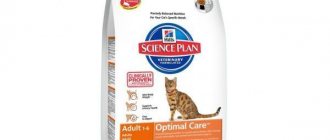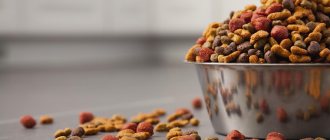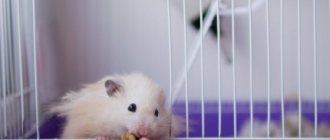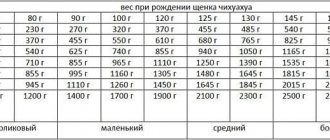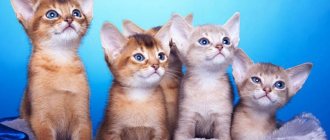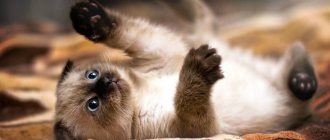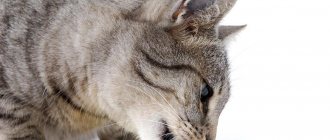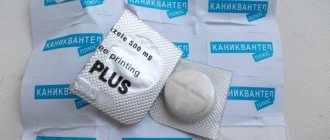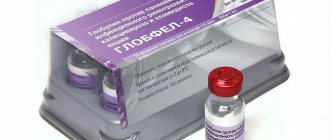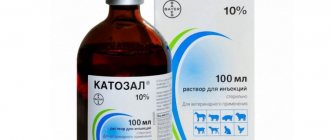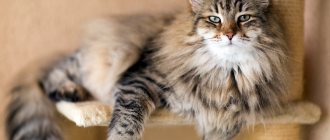Dry food
It may seem “frivolous” to most; it is often used as a complement to other, “main” food. However, for a complete diet, dry food and water are enough for the animal. If your cat eats this food throughout the day, it will replenish its entire daily requirement of nutrients for health and well-being. True, we are talking about complete food, experts clarify.
There are a number of vitamins, minerals, micronutrients, and essential fatty acids that your cat must replenish daily. There are daily standards, but it is worth considering that the lower and upper levels are usually indicated. As for the bottom, it was derived from laboratory tests, when the animals were fed different amounts of food and any deviations from good health, if any, were recorded. Based on such observations, the upper and lower levels were established.
It is important that the dry food states that it is complete, balanced or suitable for daily use: only under this condition can it be assumed that the pet will not be left without substances important to it.
– Dry food also acts as a preventative against tartar. The norm is usually indicated on the packaging, it is important not to go beyond it, notes veterinarian-therapist at the Gemini clinic Darina Berezina.
Don't forget to drink. Your cat should always have clean water.
– Cats are animals that came from the subtropics, and, like all inhabitants of semi-deserts, their body is designed in such a way that they have a reduced sense of thirst. It’s one thing when a cat eats a mouse—the rodent has enough moisture and doesn’t need to drink. This is a different case. Therefore, if your cat drinks little, then perhaps he needs to soak the food or replace it with wet food, sums up Ekaterina Nigova.
Roskoshestvo examined samples of cat food from 39 brands. Three of them are of high quality.
Feed classes
Cat food is divided not only into different types, but classes are a classification system depending on the composition, benefits and price category of the food.
Economy class
Products in this category are suitable exclusively for muffling the pet’s hunger, since they simply fill the stomach, but contain virtually nothing useful for the cat’s body, much less meat. The basis of such feeds is by-products, soy, grains, food additives, preservatives and flavor enhancers. They can be compared to fast food for people, so they are categorically not acceptable as the main food for a cat. Their only advantage is their low price.
This category can also include the so-called commercial class, which is not much different in composition from the economy class, but has a higher cost due to the promotion of the brand.
Manufacturers: Whiskas, Felix, Darling, Doctor Zoo, Meow, Friskies, Kitekat, etc.
Premium class
Unlike the previous category, the products contain natural meat and vitamin-mineral complexes, but at the same time there are by-products, cartilage, and protein of plant origin. The quality in this case is much higher than economy-class products, so eating such food is not so harmful to the pet. It is premium food that is preferred by most cat owners, since it has a relatively affordable price and increased nutritional value, which allows them to reduce the daily portion size.
There are different manufacturers in this category: some are not inferior in quality to more expensive products, while others skimp on ingredients and add large amounts of wheat, rice, and corn grits, which are poorly absorbed by the cat’s gastrointestinal tract.
Manufacturers: Royal Canin (Russia), Brit, Natural Choice, Hill's, Advance, Eukanuba, Bozita, Belcando, Matisse, Happy Cat, Flatazor, etc.
It should be noted that Hill's and Royal Canin are often classified as super-premium, since compared to others they are distinguished by better balance and the presence of medical nutrition in the assortment. But recently, veterinarians and felinologists do not always recommend these products. One of the reasons for this: the opening of production lines in Russia, which did not have the best effect on quality.
Super premium class
Super-premium food is characterized by a perfectly balanced composition, which includes all the beneficial substances a cat needs, micro- and macroelements, with the complete absence of vegetable protein, grains, dangerous dyes and carcinogenic preservatives. This food helps strengthen the immune system, improve the condition of the coat and prevent the development of urolithiasis. The price is noticeably higher than the cost of low-class products, but the information on the label exactly matches the contents of the package, which is confirmed by quality certificates.
Manufacturers: 1st Choice, Arden Grange, Nutra Gold, Cimiao, Bosch Sanabelle, Profine Adult Cat, etc.
Holistic (Human's Grade)
These are innovative products based on components suitable for human nutrition. They use only natural animal and plant ingredients, grown without added hormones and pesticides, as well as natural preservatives. Due to the fact that they are completely free of any flavorings and taste enhancers, the cat will have to be initially accustomed to such food, especially if he is accustomed to strong-smelling food. Typically, this food is used for purebred show pets, as well as for breeding animals in nurseries, which is why it cannot be found on the open market.
Manufacturers: Earthborn Holistic, Acana, Golden Eagle, Innova, Origen, Chicken Soup, Almo Nature, Natural&Delicious, Evo, etc.
Note: the digestibility of high-class feed is 80-90%, so their high cost is compensated by a small daily portion.
Wet food
Wet food (meat pieces in jelly - in bags, jars, etc.) is used more as a treat. Usually it does not contain the daily dose of all useful elements,” says Darina Berezina. – On the packaging of such food you should look for a mention that the food is balanced and suitable for the daily diet.
The doctor also considers it a good sign when the same manufacturer produces both dry and wet food. Often these are the brands that offer complete products.
Ideally, the bag or canned food should include all the necessary components. This is meat (or its processed products), amino acids, plant products (this can be potatoes, corn, etc., but most often such details are not specified in the composition), vitamins K, A, D, E, taurine, iron , copper, manganese, zinc, omega-3 and omega-6 acids.
Galina Chernova
Veterinarian-nutritionist at VetCat clinics
When looking at the composition, pay attention to the ingredient that comes first, since the order of the composition is determined by the percentage of components in the product. So, in our case, meat should come first. Our cats are carnivores that feed on mammals whose meat contains taurine. Unfortunately, cats' bodies cannot store this element, so they must consume it regularly. It is necessary for vision, cardiac activity and other physiological processes,” says Galina Chernova, a veterinarian nutritionist at VetCat clinics.
WHAT TO PAY ATTENTION TO WHEN CHOOSING CAT FOOD?
Based on my own experience, consultations with cat owners, and conversations with picky cats themselves, I would advise you to adhere to the following recommendations when choosing food for your cat:
- Learn to read labels.
You don't need to know every ingredient by heart, but you can at least compare foods from different manufacturers. We will discuss this issue in more detail below. - Choose food from large manufacturers.
Such manufacturers have invested huge amounts of money in research aimed at developing the optimal food for cats. Don't take unnecessary risks by buying "original" or discounted food, food from an unknown company, or one made specifically for your local supermarket. - The food must be appropriate for the age of the cat.
Kittens need food designed specifically for the growing cat's body. Less active cats with a tendency to become overweight can be given food with a light formula. Pregnant and lactating cats should buy food for their growing bodies, as they need more nutrients than usual. If you have an older cat, talk to your veterinarian about whether to buy a light formula food or a senior cat food. - Don't feed your cat just one food.
Buy a variety of foods to prevent your cat from becoming too picky. Alternate foods with flavors like beef, chicken, turkey, etc. Choose several manufacturers whose products you will buy. If you do this from the very beginning, the cat will not get used to any one type of food (believe me, this happens).
If your cat has a sensitive stomach or you have been feeding her one type of food in the past, the change in diet should not be too drastic. Over the course of several days, mix the new food into the familiar one so that the cat does not refuse to eat food with an unfamiliar taste. If your cat's diet includes several foods from different brands, you won't have to panic if the usual food suddenly stops being produced or disappears from the shelves of your local supermarket.
If your veterinarian prescribes a special diet for your cat, follow his instructions carefully.
You need to know exactly why and for how long your cat should be fed this way. I've noticed more than once that owners don't really understand why the veterinarian told them to feed their cat a certain food. Accordingly, such owners are not aware of the risk they are taking by neglecting the doctor’s instructions. If your cat has kidney problems, eating a piece of ham and bacon will not improve her health.
Food for sterilized cats, active or lazy couch potatoes
Some may suspect that this is ordinary food, but with different labels on the packaging. In fact, we are talking about truly special foods intended for the mentioned types, and such foods differ in composition. For example, food for active cats is higher in calories, since active animals spend a lot of energy, while food for lazy couch potatoes is lighter.
– You need to look at the bag of food for castrated or sterilized animals to see if, for example, it contains L-carnitine. This is a fat burner, which is important for somewhat passive cats prone to weight gain, explains Galina Chernova.
From the master's table
Under no circumstances should you feed your animal table scraps: for animals this food is often useless and dangerous. It is forbidden to give a cat:
- Sausage and frankfurters. Despite popular myth, these foods are harmful to the liver and heart;
- Fatty foods. Fried meat and lard are difficult to digest;
- Floury. You should not feed your pet buns, cookies, pasta: they cause bloating and negatively affect weight;
- Bones and cartilages. They get stuck in the throat. It’s better to buy a special delicacy made from veins;
- Sweets. Sugar causes obesity, diabetes in cats, and worsens the condition of teeth and general appearance;
- Chocolate and cocoa. Cause problems with the heart and blood vessels;
- Coffee, tea, alcohol. Never offer these drinks to your cat.
Remember that a cat has a different, shorter intestine, smaller size and heart. Some foods from the human table can even cause death.
Expensive vs. cheap
– There are several classes of feed. “Superpremium”, “premium”, “economy”, as well as “holistic” (Human Grade) - the quality is as if the product was made for people. In the production of such feeds, technologies are used that make it possible to preserve all the benefits of the ingredients, their digestibility is at least 80%, no by-products, only clean meat. As for the rest, the degree of presence and digestibility of useful components depends on the class,” says Galina Chernova.
And Darina Berezina recommends not to get carried away with cheap food and draws an analogy between them and instant soups like Doshirak. If you eat exactly this all the time, then gastritis will not keep you waiting. Whatever one may say, in the end the cat chooses the food itself. All you have to do is first give her a choice, and then regularly fulfill her preferences.
“If a cat likes the food, she feels good after it, she has no problems with digestion or urination, she is active and has good hair, then it suits her,” says Ekaterina Nigova. – Perhaps some cat will like food that is more expensive, and some will choose cheaper food, there is nothing wrong with that.
The doctor also explains that the classification of feed is rather arbitrary. Of course, the manufacturer understands approximately what quality customers expect from food of a certain class, and tries to meet the declared level, but in fact there are no prescribed parameters that classify food into one group or another. In Europe and America (where feed most often comes from on the Russian market), there are still organizations that certify feed and are responsible for its safety. However, even if you have “holistic” food in front of you, you cannot say for sure that it is made from the best and freshest meat, and not yesterday’s meat. Regarding controversial additives, we note that regulations determining which additives are safe and allowed for use and which are not still exist and the manufacturer is obliged to follow them.
What food do veterinarians recommend?
Veterinarians recommend not saving on your pet’s health and feeding it at least premium food. If you have the financial opportunity, it is better to give preference to super-premium products, which are characterized by a high meat content and a full range of nutrients necessary for the full development of the cat’s body. Thus, it is not so much the rating of the food that is important, but its class.
Which food is better: wet or dry?
There is no consensus among veterinarians, breeders and cat owners about which option is better: wet or dry. According to scientific research, they generally have the same composition and nutritional value, despite differences in advantages and disadvantages. Some veterinarians recommend balancing the diet, including dry food as the main food and wet food as an additional food. Others, on the contrary, do not recommend using a mixed diet, since different forms of food can negatively affect the animal’s gastrointestinal tract.
In practice, owners most often consider wet food and canned food as a supplement to the main “dry” diet and a pleasant treat. But in this case, it is important to select products from the same manufacturer. The main thing when choosing is to take into account the needs of the pet, its age, gender, health status and other characteristics.
Is it possible to feed cats food from the table?
Many owners habitually reason that if the food they eat is good for them, then it will be good for their pets, and they believe that the main rule in the diet is variety. Nutritionists do not agree with this position and explain that if you additionally give animals some other food, then the cats will not eat their own, which is why they will not receive the daily requirement of the necessary elements. Of course, if you feed your cat from the table infrequently and a little, then nothing bad will happen to it. 5–10 grams of meat (preferably cooked) or other food is most likely not dangerous for a healthy cat.
Diet
Many people are touched when they see fat cats on the street, on the Internet, on TV. All sorts of funny jokes happen to them, they look like thick balls of wool, and can barely move. But in fact, despite their cuteness, cats don’t want to be like that. They want to be healthy, not obese.
These tiny animals are susceptible to many human diseases: obesity, hypertension, clogged blood vessels and much more. If you don’t create the right diet, your pet will be in great danger, because often the desire to feed the animal to its fullest with all sorts of goodies will not bring any benefit. Because in this case the animal consumes much more energy than it expends.
With age, food portions need to be increased. For example, if you gave a tiny kitten 100 grams of food, when he grows up, you need to increase the portion to 400 grams. And, of course, the pet should have the opportunity to drink clean water at any time. When calculating the nutritional norm, you must also take into account the physical capabilities of the pet, its health and energy expended. How often to feed your cat can be found below.
Is fish harmful?
– There is a theory that it is not physiological for a cat to eat fish, since in the wild it usually does not eat such meat. But in the same way, in nature, cats do not eat rabbits and do not hunt cows, but food from these animals is actively sold, and there is nothing wrong with that, since the food is designed for normal absorption, explains Darina Berezina. – For example, salmon and trout can be classified as high-quality fish, but cheaper fish (capelin, herring, blue whiting) are rather undesirable.
This fish may contain too much iodine and other minerals that cannot be absorbed in such a volume, which causes the formation of stones in the genitourinary system, adds Galina Chernova.
“As for ordinary raw fish, it is not suitable for everyone, there is a lot of phosphorus, little calcium,” says Ekaterina Nigova. – If you are a compassionate citizen and consistently feed street cats, then dry food is perfect for them. It is also advisable to bring water to the animals, although even here they will most likely get out on their own, because in the summer you can drink from a puddle, and in the winter they can eat snow
.
Diet of your beloved pet
How many times a day to feed a cat and how many times a day to feed a cat is easy to find out.
The following are the main rules for feeding an adult pet:
- The animal must be fed at least twice. The portion is calculated depending on the energy value.
- It is necessary to weigh the mustache periodically to regulate the daily nutritional intake.
- There should be fresh drinking water near the feeder.
- It is normal to feed several animals at the same time, but it is recommended to delimit their territory. It’s better to have the bowls spaced apart from each other and at different heights to prevent “excessive appetite.” The pet may be afraid that the other cat will take the food, and therefore quickly swallow everything indiscriminately.
- If a mustache eats lazily and reluctantly through force, it means it is overeating. A safe bet is to remove the food bowl after a few minutes.
- If the pet is too gluttonous, this is not very good. Perhaps parasites have entered his body. It must be remembered that the animal can gain weight in the winter, and lose the sense of appetite in the summer in the sultry heat.
- A newborn kitten should eat every two hours around the clock. The owner feeding the pet should listen sensitively to his body, and if the kitten continues to scream, increase the dose of food.
Once your pet has grown and become stronger, you can slow down the pace of feeding. After a month, you can feed less often, because the kitten learns to drink from a saucer on its own. You can feed your ward 6 times in 24 hours, adding foods rich in calcium: liquid cottage cheese, fermented milk. Don't forget about grated meat. You can find out from your veterinarian what kind of food is best to feed your kitten.
Adult cats eat larger portions and a little less often. The feeding time and the amount of food eaten depends on the pet’s activity, its physical condition, and habits.
But for feeding an adult animal there are also several standard rules:
- It is necessary to calculate the diet so that the cat receives the same portions of food 2-3 times a day. An adult animal weighing 5 kg should receive 150-200 grams of protein and 50 grams of ballast or carbohydrate products daily. Daytime and evening portions should be the same.
- You can feed your pet at the same time as your own meals: during breakfast, lunch and dinner.
- Even if the owner is not at home, you need to ask friends or family to keep an eye on the pet, feed it 1-2 times a day, and also change the water in the saucer. Provided that your pet is already an adult and accustomed to a schedule, you can leave food in reserve. In this case, you can feed the cat dry food.
You can find out how many times a day you need to feed a cat from the video from the author. It will come in handy in life.
Features of choosing cat food
The opinions of breeders are divided: some say that natural food is better, others say that it is prepared. Even those who feed their cats ready-made food are divided into two groups, where the first claims that cats tolerate canned food best, and the other - dry food.
To figure out what is best to feed a cat at home, you need to know several rules, conditions and principles.
- Regarding canned food, you need to know that they are considered balanced and filled with all the necessary nutrients. This food can replace regular foods in food. Of course, we are now talking only about high-quality canned food, for example, about juicy meat pate.
- Dry food is easy to use and store. Among other things, feeding a cat such food is both profitable and hygienic, so there is nothing wrong with feeding a cat dry food. It is better to remember that cheap pet food contains a lot of salt, all sorts of food additives, etc., which spoil the gastrointestinal tract. It is necessary to keep a lot of water next to dry food so that the nutrients are absorbed.
- The most popular food option for cats is natural food. Almost every owner resorts to this method, thinking that there are absolutely no problems in eating natural food. Which, of course, is wrong. In this case, you should not feed the animal meat with a lot of fat, raw fish, bones and sausage. You can feed turkey and chicken, but lean ones. You can add fermented milk products to your diet: cottage cheese, milk, eggs, and kefir. This should be a treat.
It is best not to differentiate between foods, but to feed your cat dry and wet food in the morning and throughout the day. Dry food can be useful because it helps to avoid some problems associated with the oral cavity and genitourinary system. Find out how to feed a fluffy from the author of GuberniaTV.
Is it possible to give cats dog food?
Cats and dogs are different from each other, and therefore their nutritional preferences are different:
- It is normal for an adult cat to consume more protein than a dog;
- Cat food should contain some amino acids that the dog's body produces naturally.
Cats need to be fed food that is intended specifically for them in order to prevent a variety of ailments. Suitable cat food can be selected depending on the health status.
Meat and fish in the diet of fluffies
For cats to function well, they need amino acids found in meat, which is why this product is preferable to cereals, vegetables and fruits, and even dairy products. Many people don't know, but the stereotype that adult cats love milk is somewhat wrong. In any case, the more protein the cat receives, the longer it will be full and active.
Cats love fish, but you can do without it. Fish contains the necessary vitamin A and the amino acid turin, but these elements are also present in meat, so it is better to let the animal choose the product to taste.
Natural vs dry food: which is better?
In order to decide what to feed your cat, you need to consider the benefits, as well as nutritional rules.
Natural food
First of all, this includes the following products:
- meat;
- fish;
- offal;
- dairy products without additives;
- vegetables: stewed, steamed or raw;
- porridge.
When feeding an animal with meat and fish, it is necessary to get rid of bones and skin. Then boil or pour over boiling water. You can feed your cat raw only occasionally and only if you trust the seller of the product. The animal perceives not only meat, but any food better when warm. If you love to cook, you can search the Internet for recipes for making treats for your pet.
Dry food
As mentioned above, dry food is preferable for owners, and sometimes for animals if the breed is bred artificially, for example, the Scots and the British, who are also allergic and prone to metabolic disorders.
The advantages of feeding dry food include:
- constant imbalance of nutrients;
- ease of nutrition and portion control, as well as convenience;
- the opportunity to purchase food based on the animal’s personal preferences, as well as its physical condition.
Disadvantages of feeding dry food:
- high-quality feed is quite expensive;
- It should be taken into account that in wet food approximately 60% is water;
- dry food is often addictive to your pet;
- often contains too much salt.
Choosing ready-made food
Ready-made cat food relieves the owner of the need to prepare fresh food daily, and the cat from the imbalance of nutrients, minerals and vitamins. When used correctly, in compliance with feeding standards and water regime, properly selected food does not harm the cat’s health, but, on the contrary, supports and strengthens it.
Canned food
They are otherwise called wet. As a rule, these are pates or small mixtures, but there are also luxury foods containing whole pieces of meat and fish. The choice is great. Owners trust such brands as Royal Canin, Hills, ProPlan, ProNature, Cat Chow, Sheba, etc. You can select products on the official websites of manufacturers, and purchase them in pet stores.
Dry food
Dry food is easy to store, but it is important not to make mistakes in dosing. The 30-40 grams per day prescribed for a cat looks very unattractive. And the daily norm, divided into two feedings, seems meager. Will your pet go hungry? If the feeding rate corresponds to the weight and age of the cat, then nutrition and balance will be fine. But you should not add more food or keep it always available - this risks overeating and overloading the digestive system. The result is not only excess weight and heart problems, but also an excessive amount of feces, urolithiasis and changes in appetite.
Proper feeding of a cat at any age is, first of all, maintaining a balance between the needs of the body and the characteristics of the food. Choosing the type of feeding (natural or factory) and following its rules is the responsibility of the owner. Only one food option brings definite harm to a cat - sharing a meal with people: fatty, spicy, salty, peppered, fried food from a common table.
Prohibited foods for cats
Check out the list of prohibited foods and never give them to adult cats:
- Milk. Adult cats are strictly prohibited from any milk (cow's, goat's). As animals age, they develop lactose intolerance, which causes digestive disorders and diarrhea.
- Liver. A large amount of liver in the diet can cause vitamin A intoxication. As a result, osteoporosis develops and bones become deformed. Raw liver is also dangerous because it may contain helminth larvae - a risk of helminthic infestation.
- Raw meat. Before feeding, the meat must be frozen in a deep freezer and doused with boiling water before serving.
- Canned fish. Canned food for people contains a lot of oil and preservatives - this is harmful to the liver and can cause obesity.
- Raw freshwater fish – can contain all sorts of parasites.
- Sausages and smoked meat (lard), regardless of their composition, are harmful. These products are also human and contain a lot of fat, salt and other ingredients that are not necessary for the animal.
- Fatty meat, cottage cheese, dairy products, butter, cheese - all this is not necessary for a small pet, as it can lead to digestive problems and obesity.
- Bones, both fish and bird. The sharp edges of the bones can injure the esophagus, stomach or intestines, or become lodged in the throat.
- Raw chicken eggs. There is a high risk of infection with salmonellosis or E. coli. Only quail eggs are allowed in their raw form.
- Pork. Meat that is too fatty for cats can cause indigestion and diarrhea. In addition, pork meat is more likely than other varieties to be infected with helminth larvae and viral infections.
- Dry and wet dog foods do not contain the nutrients your cat needs. Eating dog food can lead to exhaustion and illness in your pet.
- Yeast dough and flour muffins based on it. Once in the cat's stomach, the dough swells and greatly stretches it - this causes severe pain. The breakdown product of yeast is alcohol, which can cause poisoning.
- Onions and garlic are very toxic to cats in any form: raw, powdered, or in food. Poisoning with onions and garlic causes gastrointestinal upset and, in advanced cases, causes anemia.
- Coffee, tea, cocoa and other products containing caffeine. Caffeine is a deadly substance for cats that causes rapid breathing and heart palpitations. In severe cases, cardiac arrest may occur.
- Chocolate. Contains a lot of sugar and a substance dangerous to animals - theobromine. Convulsions, tachycardia, and death are possible.
- Sugar, sweeteners and sweets. Large amounts of sugar lead to obesity and diabetes. Sweets often contain the sweetener xylitol, a substance toxic to pets. Xylitol poisoning may cause vomiting, convulsions, loss of coordination and lethargy. Possible development of liver failure.
- Grapes and raisins are toxic to pets. In case of poisoning, vomiting and hyperactivity occur. Provoke kidney failure.
- Mushrooms. Heavy and very toxic product. In case of mushroom poisoning, increased salivation, vomiting, and diarrhea are possible. Possible liver damage.
- Nuts. Some varieties of nuts (macadamia nuts, walnuts) are poisonous to cats, and excess fat content can cause diarrhea and vomiting.
- Alcohol. Poisons the brain and liver of the animal. Possible death.
Products that should not be abused
Of course, sometimes exceptions can be made. For example, chips seem to be very tasty for humans, but eating them all the time is highly undesirable. Likewise, for cats, for example, ice cream is harmful, but very rarely you can give it a spoon.
List of foods not recommended for cats:
- Apples. You can give a little at a time. Be sure to peel the peel and remove the seeds - they contain toxins and a toxic substance such as arsenic.
- Avocado. The peel and pit contain a dangerous toxin - persin, which causes gastrointestinal upset. The oily texture of avocado attracts cats; one small piece without the peel is quite harmless.
- Potato. Raw potatoes, leaves and stems of the plant contain the harmful substance solanine, a poisonous alkaloid. Potatoes can be given boiled, but they have no nutritional value for cats.
- Broccoli. You should not overfeed your pet with this type of cabbage; it contains a large amount of toxins. In moderation, broccoli is healthy.
- Bread and pasta in large quantities provoke flatulence and intestinal colic. A small piece of whole grain bread will not harm the animal.
Important!
It is not advisable to feed cats a mixed diet - dry food and natural food. The stomach secretes different enzymes to digest different types of food. Mixed foods can cause digestive system problems.
